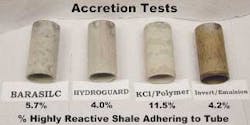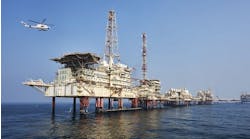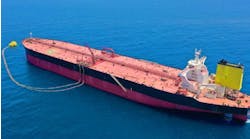Developed for maximum shale inhibition in the Gulf of Mexico
Jennifer Pallanich Hull Gulf of Mexico Editor
Developed to deal with gumbo-type form-ations in the Gulf of Mexico, Halliburton's Hydro-Guard fluid system has already been put to the test in eight shelf and eight deepwater wells.
On the road to creating Hydro-Guard, Halliburton's staff focused on finding water-based muds that have the properties of invert-emulsion mud. Topping the requirements list were high penetration rates and creation of a workable wellbore, said Gary West, Baroid product development manager.
"Water-based muds have always fallen short on those performance issues," he said.
Hydro-Guard can give closer penetration rates to invert than existing water-based muds, West said of the solution to highly reactive clay formation challenges in GoM.
"It's the best shot we've seen to date," he said.
The Baroid product service line of Halliburton business unit Halliburton Energy Services developed the water-based fluid for maximum shale inhibition in highly reactive formations like those found in the GoM. Hydro-Guard prevents hydration and disintegration of clay-rich formations, especially in gumbo, the company said.
"Development of Hydro-Guard was in answer to our clients' requests for an effective water-based fluid that offers good inhibitions in highly reactive clay formations," said Craig Floyd, Baroid product service line senior vice president.
The penetration rates achieved with the Hydro-Guard system in the wells in the Gulf either equaled or exceeded the performance observed on offset wells where synthetic-based fluids or other highly inhibitive water-based fluids were used, according to Halliburton.
The Houston-based service company expects the fluid system to see use in areas where the discharge of cuttings contaminated by synthetic-based fluids is not permitted, like the eastern GoM.
Tom Wilson, superintendent of drilling and completions in the integrated solutions group, said Hydro-Guard helped in a well drilled over the turn of the year near a major salt dome on the shelf. The side track was not expected to hit salt, but the well encountered a ledge of salt 1,100-ft thick. With Hydro-Guard, the wellbore went through the salt and 1,200 ft of hole subsalt, he said of the S-shaped well. Wilson said this was his first experience with Hydro-Guard.
There were "no drag or torque problems that I would attribute to the mud or shale," he said. Progress halted a few times after getting stuck in the salt, he said, but the drilling team took advantage of the fluid's properties, using seawater pills to get free within an hour or two in each instance. Wilson said consensus of the drill team is that that if they had drilled into the unplanned salt with regular water-based mud, it would have been harder to get free.
He said drill rates were double for the system using Hydro-Guard than an offset well drilled with oil-based mud and eight- to ten-times faster than an offset well using a normal water-based mud.
"That said, we were cheating," he said. The rig, working in 60 ft of water, was using Sperry Sun's GeoPilot rotary 3D steerable system, the Insite Anywhere visual system that allows remote monitoring of the well's progress, and Hydro-Guard. The best progress came with the four-blade FS 2441 bit rather than the six-blade PDC bit, he added.
"We used all the weapons in the new arsenal," Wilson said. "The combination of Hydro-Guard, GeoPilot, and the FA 2441 bit is tremendous. Anytime I've got a well that's within the temperature range of Hydro-Guard, I'm going to run it."
An additional benefit is that using Hydro-Guard means not having to go through the grinding and drying process before running cuttings to shore, he said. This is especially useful, he said, with rigs that have limited space.
A last hurdle
The biggest problem faced in developing Hydro-Guard, West said, was inability to tolerate ultra fine drill solids. The solution involved finding a way to commercially extract the drill solids. Halliburton's system uses the new flocculent Clay Grab to coagulate the ultra fine drill solids and pull them out.
null
"We are now able to extract the contaminant that we were not able to cope with before," West said.
The system opened the workable window of non-dispersible polymer mud, he said.
Field tested in early 2002, the Hydro-Guard system provides wellbore stability, high rates of penetration, and acceptable rheological properties over a range of temperatures.
During a recent GoM effort to drill 3,200 ft of 17-in. hole, use of Hydro-Guard yielded a low 7.5 methylene blue test (MBT), compared with 25-30 MBT for a typical partially hydrolyzed polyacrylamide polymer fluid under equivalent drilling conditions, the company said. The drill solids were flocculated, encapsulated, and removed from the system with conventional solids control equipment. At the shaker, cuttings appeared crisp and glossy, indicating excellent inhibition, Halliburton added.
West said deepwater is the biggest market for Hydro-Guard because of the gumbo-like conditions in that area of the Gulf.
"In a deepwater operation, penetration rate is the name of the game," he said.
The fluids can offer penetration rates close to those of invert fluid, West said.
"The biggest thing we've learned about this system is that it does require some good engineering," he said.
Balancing required maintenance and treatment for big and fast hole operations against economics is one focus, he said. Polymers need to be replenished based on barrels per day of dirt drilled, West said, noting silt stone and the Gulf's gumbo, which "eats the polymer the quickest," require different maintenance levels.
The system
The system is a combination of two new polymer chemicals and an amine polymer. Hallibur-ton's two new, patent-pending chemicals combine with the third polymer for a synergistic effect in which there is no dispersion while shale stability is maintained. Extremely lubricious, the combined fluid is low in colloidal content, West said, contributing to the "excellent penetration rate."
The company tested "every kind of shale inhibitor we could lay our hands on," he said, noting the scrutiny extended to linear swell testing and shale dispersion testing.
The goal was to make the polymers quickly adhere to the clay so no water would enter or exit the clay to prevent interference with the clay mineralogy.
"That keeps the rock in Mother Nature's native state," West said.
The results led to the combination of flocculent Clay Grabber and inhibitors Clay Sync and Clay Firm.
The flocculent is effective at low concentrations, allowing the encapsulation of drill solids as they are produced at the bit. Clay Sync and Clay Firm prevent hydration and disintegration of clay-rich formations, especially in troublesome gumbo-type formations.
Hydro-Guard produces a filter cake with an extremely low lift off pressure that should not require remedial treatment for clean up, West said. If a remedial treatment is desired, a simple oxidation flush would dissolve any remnant polymer, he said.
Dollars and sense
An average deepwater GoM well reportedly loses 2,500 bbl of synthetic mud. Because less Hydro-Guard will be lost to any theft zone, the Hydro-Guard will present a 20-25% savings despite its higher maintenance costs, West said. A bonus, he said, is that Hydro-Guard provides better leak-off data in terms of formation integrity test results.
Typically, when using conventional water-based fluids, gumbo chains and boxes must be cleaned every few hours or they become plugged by lumps of clay. Hydro-Guard coats the highly reactive clays, reducing the bit and bottom hole assembly balling problem that affects the overall drilling rate and decreasing the need to spend expensive rig time removing accretion from the bottom hole assembly and bit.
Hydro-Guard works to 300° F and 16.5 lb/gal density, so the fluid is not currently intended for work below 15,000 ft, the company said.
"That's the biggest restraint we have," West said.
The company is now working on a fluid for use to 375° F.




